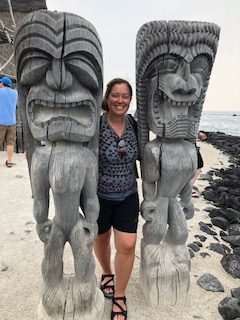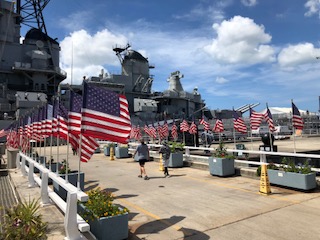Mrs. Brubaker Leads Summer Hawaii Trip
November 26, 2018

For Mrs. Helen Brubaker, a freshman English teacher at Carroll, the sound of the bell ringing on that last day of school meant preparing for the trip of a lifetime—a school-organized trip to the tropical island of Hawaii.
The excursion was originally organized by Mrs. Wisehart, also an English teacher at Carroll; however, she found herself in a position that didn’t allow her to travel with the group. Her husband had been given an opportunity to go Israel and the timing of the two trips wouldn’t work out. When Brubaker heard that the trip to Hawaii needed a new leader, she eagerly jumped on the opportunity.
“It’s always been something on my bucket list,” Brubaker said.
After months of planning and counting down the days until the big trip, the time finally came. Their flight took off in the beginning of June from Detroit where they landed in Seattle. From Seattle, they then boarded a six-hour flight to the big island of Hawaii. While the trip was long, it was a great way for the different groups of students to meet and mingle.
Representing Carroll High School was Brubaker and a student with her two parents. Along with CHS, multiple other schools from across the United States joined them; students from Florida, Arizona, and many other states.
“We were able to mesh with them, but we also were able to do our own thing. It was the perfect sized group,” said Brubaker.
The first three days of the trip were spent in the little town of Kona, where small mom and pop shops lined the streets. Brubaker explained that the time relaxing in Kona was easily one of her favorite parts of the trip.
“Our hotel was really beautiful when we were in Kona. It was right on the water and also had a swimming pool down below, so it was just really relaxing,” Brubaker said.

From Kona, the group boarded a short flight to the big city of Oahu where Pearl Harbor is. They got to see the U.S.S. Arizona, a bombed ship during Pearl Harbor where 1,177 of the 1,512 crewmen on board at the time were killed. They also got to walk through areas where the crews ate, filled with all types of guns and uniforms from that era of World War II.
“They have really unique artifacts which tie into Unbroken, a novel that a lot of the freshman read,” Brubaker said.
In addition to the historical aspect of the trip, science also played a key role in the educational ties of the excursion. The group got to hike in a rainforest, looking at all different species of vegetation, plants, and wildlife.
A college professor gave them a tour through the Kona Cloud Forest where, “You can really feel the mist and clouds,” said Brubaker. “There is bright vegetation, trees, and parrots. You feel like you’re in Jurassic Park.”
Brubaker explained that the culture of Hawaii is not too different from the continental United States. Most of the people looked American, with hardly any true Hawaii natives remaining.
“They’ve really become quite the blended area. Very few 100-percent Islanders remain,” said Brubaker.
One apparent difference between Hawaiian culture and American culture; however, can be seen right on the streets of the island. Homelessness is a problem throughout all parts of the world, but there is one distinct difference between the homeless in Hawaii versus the homeless in America.
“Here in the United States, you might see [homeless] people strumming on music, but what they would do is collect flowers from the different bushes around and make beautiful scenes with live flowers and then people would donate to them,” said Brubaker.
Due to the high and rising unemployment rate in Hawaii, more and more Hawaiians are experiencing homelessness. Making flower arrangements and baskets out of palm branches help the homeless earn some extra money here and there.
While most of the trip went smoothly, they did have one bump in the road. Due to volcanic action in surrounding areas, they were unable to explore the National Volcanic Park and see the famous waterfalls.
“Where we were there wasn’t really any obvious signs of volcanic problems to disrupt our plans, except for that the sky wasn’t quite as clear when you look out into far away distances,” said Brubaker. “But just to keep us super safe, they restricted travel to that area.”
This change in plans was a bummer for Brubaker and the students, but they hope to make the trek to the national park next summer during the trip to Hawaii in 2019.
“We will see a lot of the same things on this next trip. We’re hoping that the National Park Services opens up Volcanic National Park and that we get to see more of the black sand beaches,” said Brubaker.
Next summer’s trip is scheduled for June 13-18 and will also be led by Brubaker. She is looking forward to more students interest this time around and hopefully more students to join her. The cost of the trip can be inhibiting for many families, but she encourages students to at least consider it. While it does cost roughly $3,500-$4,000, the organization, World Strides, offers scholarships to some students and the cost can be split up into multiple different payments.
“Traveling is a great way to see history and science come to life and to learn about other cultures,” Brubaker said. “It’s also a good way to learn about yourself and put yourself out there. It’s a safe way to travel and is just amazing.”

